Part V…The Savage Mountain
*This post originally appeared on the blog in early 2018…We have re-posted for the enjoyment of all during our ‘Summer re-runs” while Brian and Sylvia are in search of new adventures.
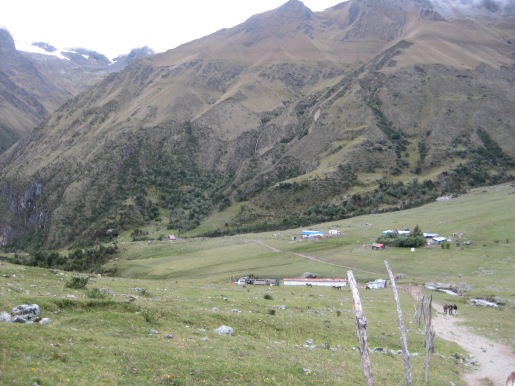
We awoke early in search of breakfast; I was feeling better. It had been a long night. Poking my head from our tent out into the larger pavilion, I saw that fresh sand had been dumped by one of the porters atop a German tourist’s puddle of vomit. A pair of indescribably filthy chickens, and a pack of apparently ownerless dogs, entered and left the tent pavilion as they pleased and went running up and down the aisles looking for scraps. We went out into the cold air, dodging the filthy chickens, to reach the bathrooms such as they were; blocky concrete outhouses with creaky plywood doors and seat-less toilets. These would still far outstrip the facilities we would enjoy on some later adventures.
The guide, Willie, asked me how I felt and whether I thought I could make it. I replied, to my surprise, that I felt fine and strangely energized, and that I would give it a go. One of the other members of the party had already decided the pass was too much and had hired a horse (available for just a few dollars.) I had no intention of being horsed up if I could avoid it; I intended to at least attempt to walk. Willie, apparently no cowboy himself, seemed pleased with this.
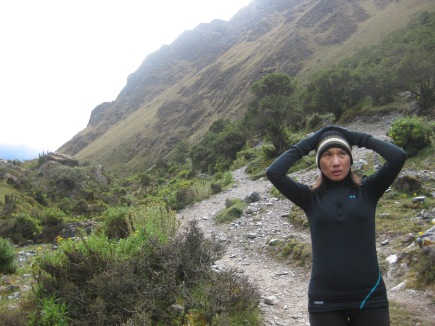
We left the camp of Soraypampa. The trail, now much less a road and now more like a proper hiking trail, rose quickly out of the broad valley and turned into a narrower ravine, with walls quite high, and above these we glimpsed the sinister forms of exposed rock and ice. The ground was pebbles and sand, glacial talus with no mud, the footing was good. Not too steep. Breathing was hard, the air was thinning with every step. Behind us, clouds closed into the valley; ahead, the sun seemed to be promising to reveal something.
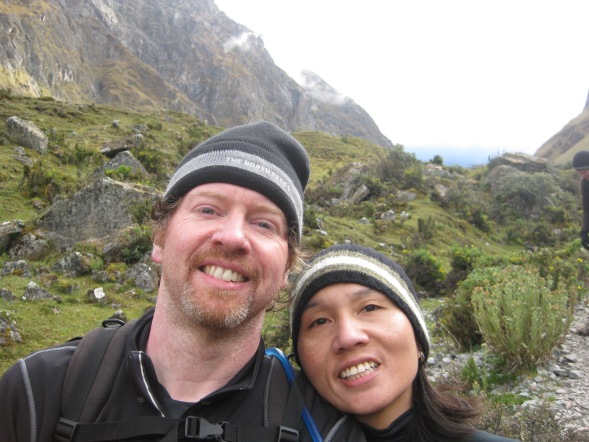
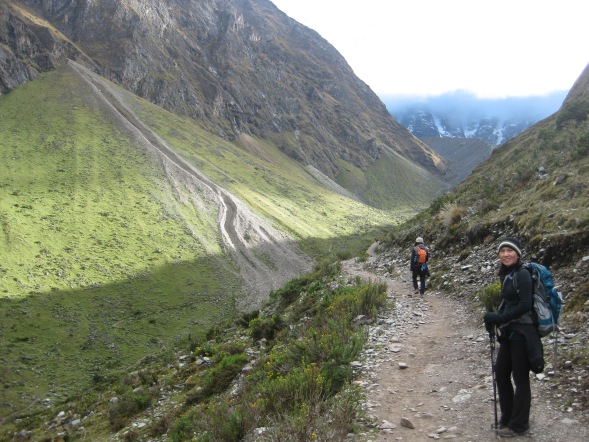
At a conjunction of narrow, swift flowing streams we stopped. Here, humans, horses and mules came and went from all directions; it was some sort of a high level intersection in the trail network. As we rested here, taking a break while filming, I turned suddenly to witness an unbelievable sight…behind where Sylvia was standing, the clouds were dissolving, revealing a bright, white, snow-covered mountainside, brilliant in the morning sun, impossibly close and huge. It was Salkantay…whose name in Quechua means, “Savage Mountain.”
We realized now what we were headed toward. I have never seen a mountain fill the horizon in such a way…not the Rocky Mountain when first I saw them rise over the Wyoming plains almost 20 years go, and not even when I first beheld Rainier. I felt as if, for the first time, I was seeing a true mountain. And in truth, I had never seen one this big before. Salkantay would be the biggest mountain in the lower 48 of America…by 5000 or more feet.

After gawking at this for a few minutes it was away and up toward the day’s high point…the 4600 meter Pass of Salkantay. All downhill from there we were told, but it was a long way yet. My struggles of yesterday appeared to be behind me, but as we trudged forward, gasping for oxygen with every step, it became Sylvia’s turn to feel sick. She had gotten some sort of cold and now it was starting to affect her, clogging her sinuses and affecting her stomach. But there was no going back now. She soldiered on and, with myself feeling inexplicably strong, we hiked.
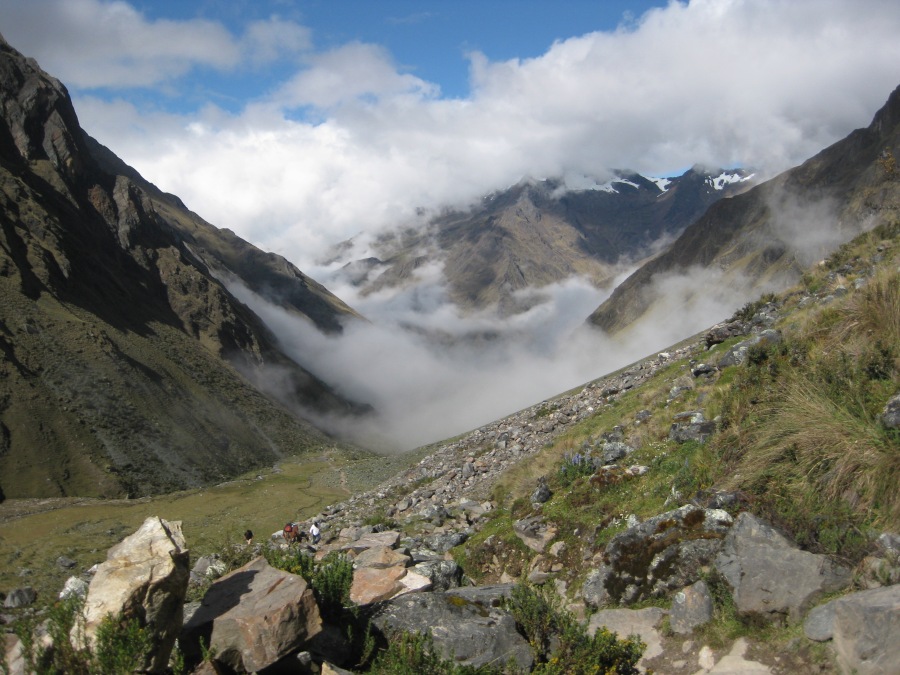

As we ascended the narrow switchbacks we began to pass the exhausted hikers from the first party, which had left more than an hour before us. Most of this party was older, more encumbered and in general less well conditioned than our party…plus it included a small menagerie of chain smokers and more than one loudmouth. I passed one man, out of breath but still pausing to take a smoke break in the clear air at 14,000 feet or so. We also passed that groups unofficial photographer…a young Chinese man, student by the look of him, carrying a backpack that could not have weighted much less than himself, full of cameras and camera gear. He smiled weakly as we passed him, apparently intent on filming his own complete documentary of the hike regardless of what it took.
At a high alpine tarn we paused to rest and regather our strength…the stop was well timed. Not far now from the pass, we were assured. As we lay there by the still waters of the pond, a sudden clamor erupted, what sounded like a dozen blacksmiths striking on anvils…clang! Clang! Clang!, over and over. A procession of mules drew into view, maybe two dozen in all, and to the backs of each one was hitched a pair of pressurized propane gas canisters, and it was these that were the source of the commotion, banging together with each step of the mules. The gas was probably destined either for the pavilion we had just left or one of the eco-touring lodges. The convey was gone almost as soon as it had come, though the sound of the clanking lingered in the air for a while. We heard no explosion, so it must be presumed they reached their destinations intact.
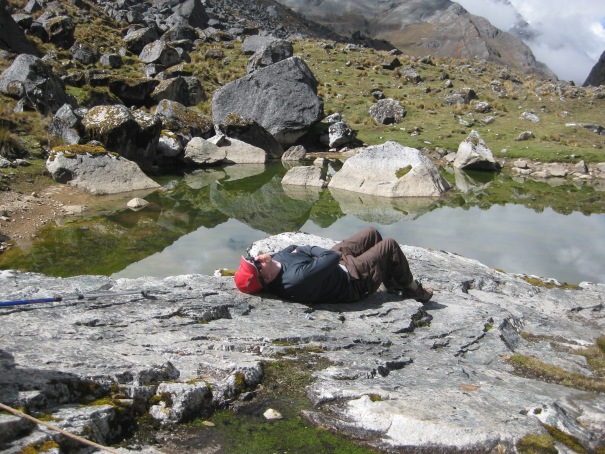
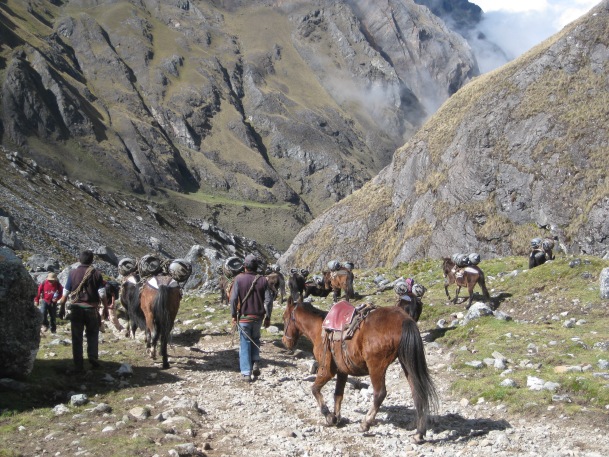
On we continued, and the glaciers to either side of us seemed deceptively close now in the clear thin air…so close we could almost touch them. And there suddenly…there it was! The Pass of Salkantay loomed before us.
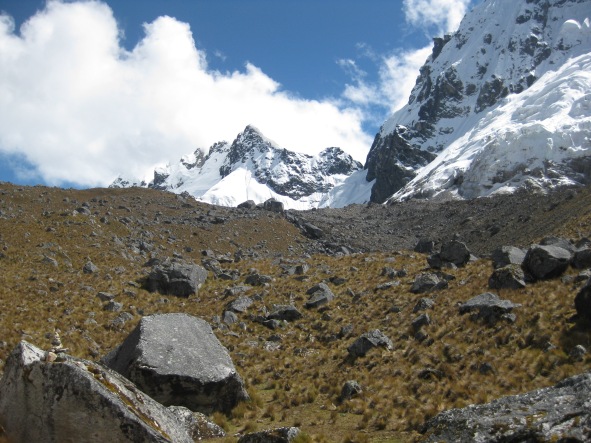

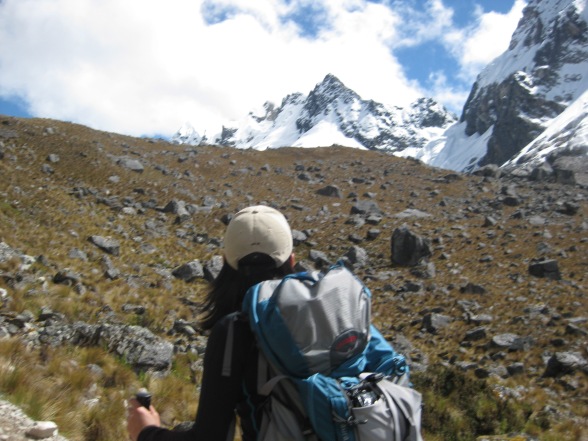
And we were there! At the pass, which stands higher than the highest point in the continental United States, we paused for a group photo. The Savage Mountain, Salkantay, towered another 5000 feet above…making it approximately the same size as Mt. Denali, North America’s highest point. We were told by the guides that a Japanese expedition had attempted the summit earlier that year but had been forced to turn back, two of their number nearly perishing.
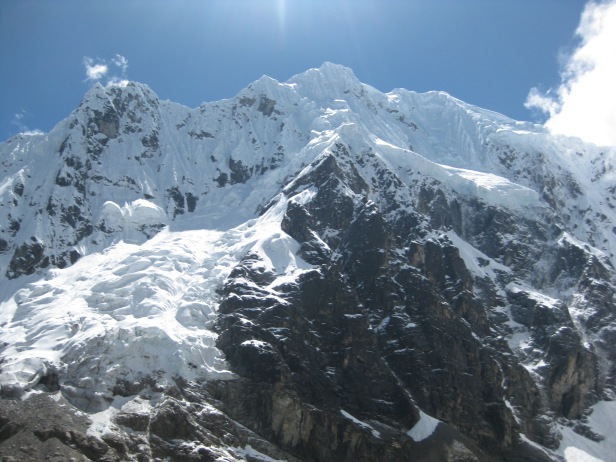
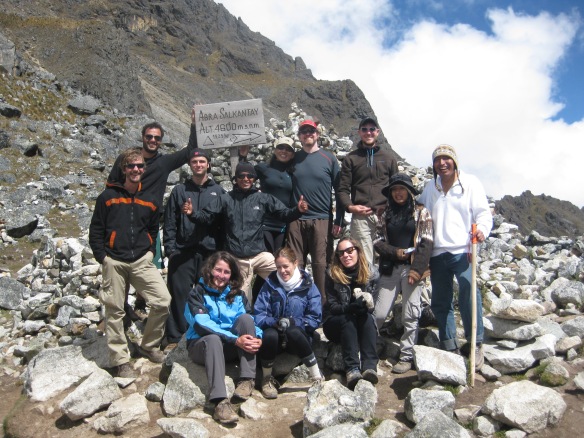
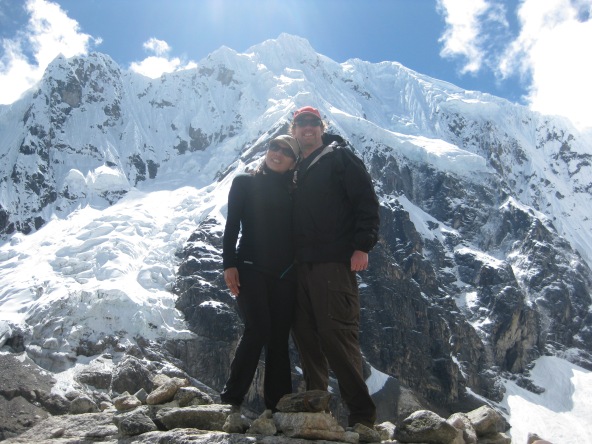
I had recently watched the amazing documentary film ‘Touching the Void’, whose events had transpired somewhat to the north in the Cordillera Blanca (where we would hike three years hence.) I was pleased to be able to observe the strange Andean snow conditions that British climber Joe Simpson had described in the film…almost sculpted ridges of snow hanging from near vertical ledges high above. You can see some of them in the pictures.
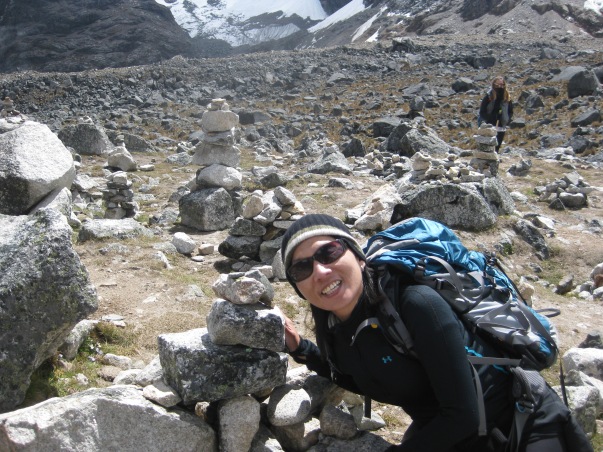
After depositing a rock as a gift for the Apu’s (mountains spirits) we began to head down. We had a long way to go…the day was not done yet. As we departed, finally struggling up the slope came our film-making fellow hiker with his gargantuan pack. He managed, barely, to make the pass and the collapse. We didn’t stick around to be part of the film, if it ever happened.
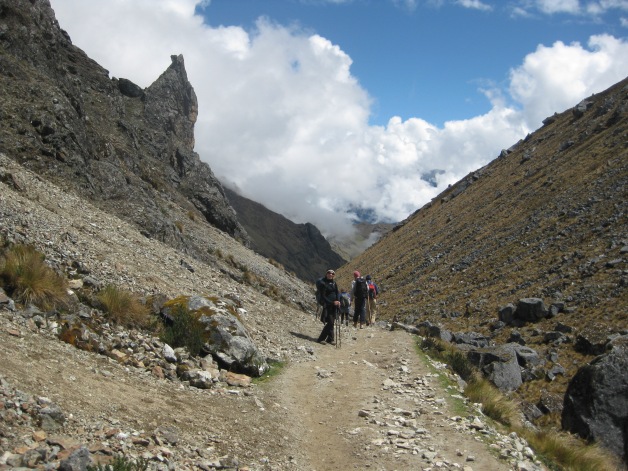
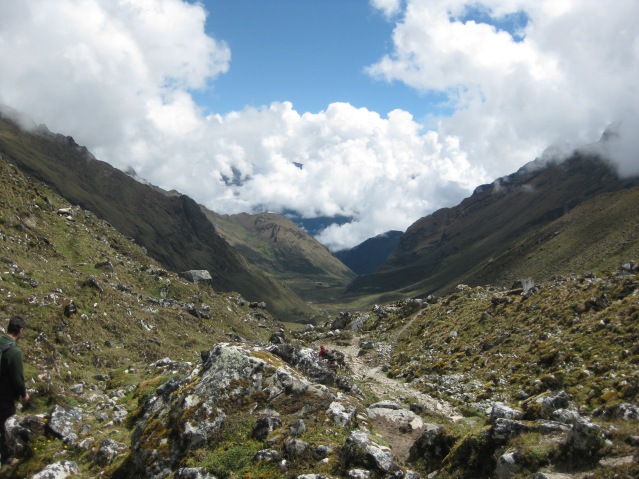
The downhill was not especially difficult, passing through a series of windswept, scrubby moorlands not unlike something one might expect to see in Scotland or Iceland. In a wide valley full of bleating sheep and mooing cows, we had lunch; the weather was clearly socking in on us, the peaks above now obscured by cloud. Some were camping here but out group still had miles to go, so we moved on. It began to rain as we passed through the remote village of Huaracmachay. Below the village we re-entered the high jungle and continued to descend along the valley of a river running far below. Here, it was humid, and we began to be attacked by some strange, arrow-shaped black fly that we would see again in Peru on the Santa Cruz Trek. It did quite a number on my legs.
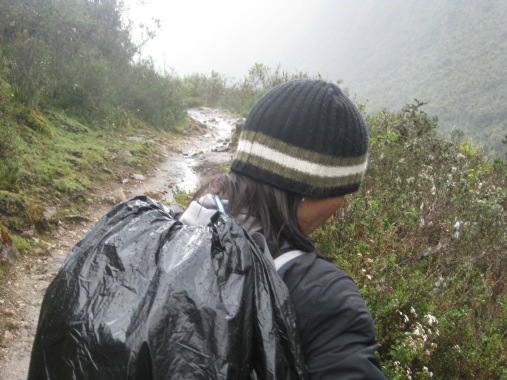
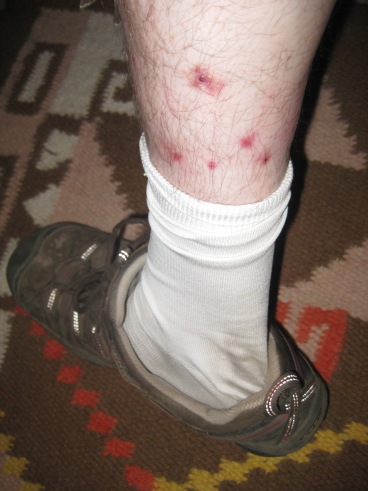
Long, long descent and then finally, from behind a bend of the valley ahead, straight lines of the type that nature abhors appeared. We had reached the village of Chaullay. In the hostel (basically, barnyard in which tents had been erected) we would eat and spend the night. Sylvia collapsed into the tent, sick and exhausted…but fortunately, the Peruvian Doctor travelling with us had brought his medical bag and freely offered it to her, which helped tremendously. The trip was far from over and we still had a long way to go to reach Machu Picchu but…we had seen the hardest the mountain would throw at us.
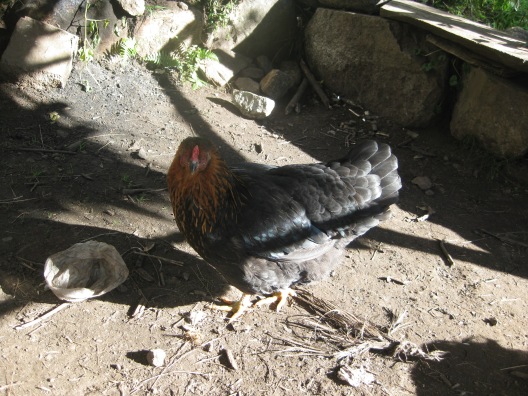
Next…Hot Water at Aguas Calientes